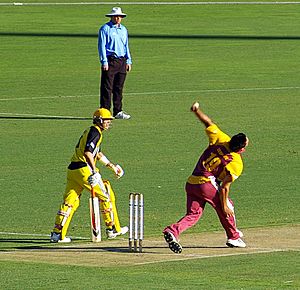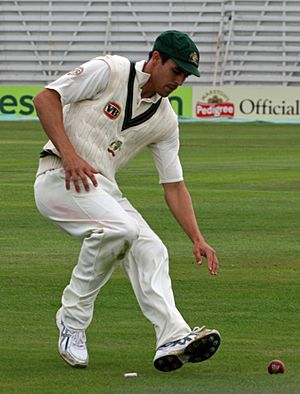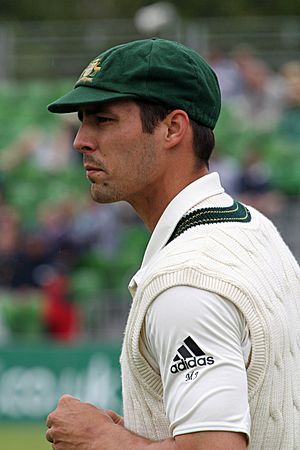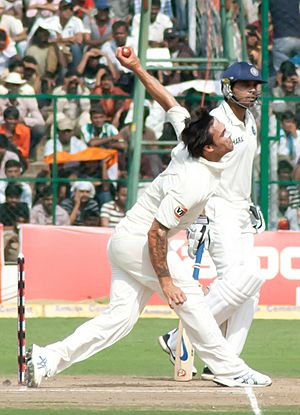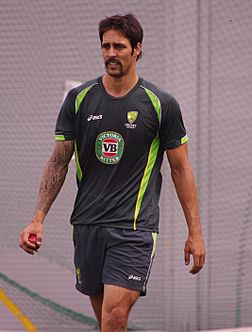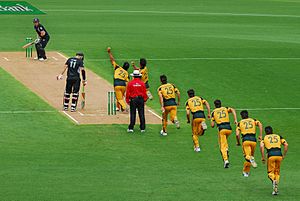Mitchell Johnson facts for kids
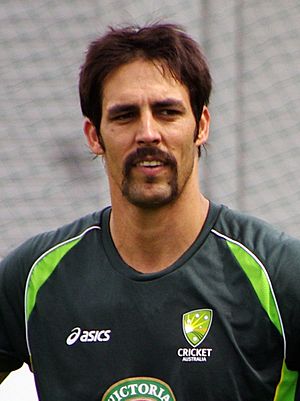
Johnson in January 2014
|
||||||||||||||||||||||||||||||||||||||||||||||||||||||||||||||||||
| Personal information | ||||||||||||||||||||||||||||||||||||||||||||||||||||||||||||||||||
|---|---|---|---|---|---|---|---|---|---|---|---|---|---|---|---|---|---|---|---|---|---|---|---|---|---|---|---|---|---|---|---|---|---|---|---|---|---|---|---|---|---|---|---|---|---|---|---|---|---|---|---|---|---|---|---|---|---|---|---|---|---|---|---|---|---|---|
| Full name |
Mitchell Guy Johnson
|
|||||||||||||||||||||||||||||||||||||||||||||||||||||||||||||||||
| Born | 2 November 1981 Townsville, Queensland, Australia |
|||||||||||||||||||||||||||||||||||||||||||||||||||||||||||||||||
| Nickname | Midge, Notch | |||||||||||||||||||||||||||||||||||||||||||||||||||||||||||||||||
| Height | 189 cm (6 ft 2 in) | |||||||||||||||||||||||||||||||||||||||||||||||||||||||||||||||||
| Batting | Left-handed | |||||||||||||||||||||||||||||||||||||||||||||||||||||||||||||||||
| Bowling | Left-arm fast | |||||||||||||||||||||||||||||||||||||||||||||||||||||||||||||||||
| Role | Bowler | |||||||||||||||||||||||||||||||||||||||||||||||||||||||||||||||||
| International information | ||||||||||||||||||||||||||||||||||||||||||||||||||||||||||||||||||
| National side |
|
|||||||||||||||||||||||||||||||||||||||||||||||||||||||||||||||||
| Test debut (cap 398) | 8 November 2007 v Sri Lanka | |||||||||||||||||||||||||||||||||||||||||||||||||||||||||||||||||
| Last Test | 17 November 2015 v New Zealand | |||||||||||||||||||||||||||||||||||||||||||||||||||||||||||||||||
| ODI debut (cap 156) | 10 December 2005 v New Zealand | |||||||||||||||||||||||||||||||||||||||||||||||||||||||||||||||||
| Last ODI | 29 March 2015 v New Zealand | |||||||||||||||||||||||||||||||||||||||||||||||||||||||||||||||||
| ODI shirt no. | 25 | |||||||||||||||||||||||||||||||||||||||||||||||||||||||||||||||||
| T20I debut (cap 24) | 12 September 2007 v Zimbabwe | |||||||||||||||||||||||||||||||||||||||||||||||||||||||||||||||||
| Last T20I | 31 August 2013 v England | |||||||||||||||||||||||||||||||||||||||||||||||||||||||||||||||||
| T20I shirt no. | 25 | |||||||||||||||||||||||||||||||||||||||||||||||||||||||||||||||||
| Domestic team information | ||||||||||||||||||||||||||||||||||||||||||||||||||||||||||||||||||
| Years | Team | |||||||||||||||||||||||||||||||||||||||||||||||||||||||||||||||||
| 2001–2008 | Queensland | |||||||||||||||||||||||||||||||||||||||||||||||||||||||||||||||||
| 2008–2015 | Western Australia (squad no. 25) | |||||||||||||||||||||||||||||||||||||||||||||||||||||||||||||||||
| 2013 | Mumbai Indians (squad no. 25) | |||||||||||||||||||||||||||||||||||||||||||||||||||||||||||||||||
| 2014–2016 | Kings XI Punjab (squad no. 25) | |||||||||||||||||||||||||||||||||||||||||||||||||||||||||||||||||
| 2016-2018 | Perth Scorchers (squad no. 25) | |||||||||||||||||||||||||||||||||||||||||||||||||||||||||||||||||
| 2017 | Mumbai Indians (squad no. 25) | |||||||||||||||||||||||||||||||||||||||||||||||||||||||||||||||||
| 2018 | Karachi Kings (squad no. 25) | |||||||||||||||||||||||||||||||||||||||||||||||||||||||||||||||||
| 2018 | Kolkata Knight Riders (squad no. 25) | |||||||||||||||||||||||||||||||||||||||||||||||||||||||||||||||||
| Career statistics | ||||||||||||||||||||||||||||||||||||||||||||||||||||||||||||||||||
|
||||||||||||||||||||||||||||||||||||||||||||||||||||||||||||||||||
|
Medal record
|
||||||||||||||||||||||||||||||||||||||||||||||||||||||||||||||||||
|
Source: ESPNcricinfo, 17 November 2015
|
||||||||||||||||||||||||||||||||||||||||||||||||||||||||||||||||||
Mitchell Guy Johnson (born 2 November 1981) is a former Australian cricket player. He played all types of cricket for his country. He was a left-arm fast bowler and a left-handed batsman. Johnson played for Australia in international cricket from 2005 to 2015. Many people think he was one of the best fast bowlers of his time.
During his career with Australia, Johnson helped the team win several important titles. These included the 2007 Cricket World Cup and the 2015 Cricket World Cup. He also won the 2006 ICC Champions Trophy and the 2009 ICC Champions Trophy.
Johnson received the International Cricket Council's Sir Garfield Sobers Trophy in 2009. This award is for the best cricketer of the year. After a tough period in early 2013, he made a great comeback. He was especially successful in the 2013–14 Ashes series against England in Australia. He was so good that he won his second Sir Garfield Sobers Trophy in 2014. He also won the ICC Test Player of the Year award that same year. Johnson played a big part in Australia winning the 2015 Cricket World Cup for the fifth time.
Johnson stopped playing international cricket in November 2015. He had played a total of 256 matches for Australia. He was the last active Australian player with a Test cap number in the 300s. Johnson was also the fastest bowler to reach 150 Test wickets, doing it in just over two years. In August 2018, Johnson announced he was retiring from all forms of cricket.
Contents
Mitchell Johnson's Early Life
Johnson was born and grew up in Townsville, Queensland. His first favorite sport was tennis, and his hero was Pete Sampras. When he was 14, he had a chance to move to Brisbane to play more tennis, but he said no. Johnson didn't start focusing on cricket until he was 17 years old.
Starting His Cricket Journey
When Johnson was 17, he went to a fast bowling clinic in Brisbane. There, a famous former Test bowler named Dennis Lillee saw him. Lillee said Johnson was a very rare talent. Lillee then helped Johnson join the Australian Cricket Academy in Adelaide.
Johnson later played for the Australian Under-19 team that visited England in 1999. However, he had many back injuries that made it hard for him. He got better and started his first-class career two years later. He was chosen to play state cricket for his home state, Queensland. In a game for Queensland against New Zealand, Johnson hit a six off the very first ball he faced in first-class cricket. In September 2005, he was part of the Australia A cricket team that toured Pakistan.
On 25 July 2008, Johnson moved from the Queensland Bulls to the Western Warriors.
Mitchell Johnson's International Career
First Steps in International Cricket (2005–2006)
In December 2005, Johnson was picked for the Australian One Day International (ODI) team. He played his first match against New Zealand in Christchurch. The selectors said they chose him to help prepare players for the future.
Johnson showed how good he could be in an ODI against India in Malaysia. This was only his seventh international game. He took 4 wickets for just 11 runs in 4 overs. This included the wickets of famous players like Sachin Tendulkar and Rahul Dravid. Johnson then played in the Australian team for the 2006 ICC Champions Trophy. In a match against England, he took 3 wickets for 40 runs.
Johnson was chosen for the squad for the first Ashes Test in November 2006. However, he was the 12th man in all the games, meaning he didn't play.
Rising Star (2007–2008)
On 26 January 2007, Johnson took 4 wickets in just 8 balls against England. This earned him the "man of the match" award. In October 2007, Johnson helped Australia win the ODI series in India. He took the most wickets in that series, with 14. This showed he could perform well even on slow pitches. In the fifth ODI, he took 5 wickets for 26 runs, his first time taking five wickets in an international game.
On 10 November 2007, Johnson made his Test match debut against Sri Lanka. He played at his home ground, the Gabba. Johnson took his first wicket, catching Thilan Samaraweera. He ended up taking 4 wickets for 96 runs in the match.
On 19 January 2008, Johnson scored his first Test half-century against India in Perth. Australia, however, lost that match.
In the first Test against South Africa in Perth, Johnson had an amazing day. On 18 December 2008, he took seven wickets for only 12 runs. He took five wickets for two runs very quickly, bringing the South African team from 3 wickets down for 234 runs to 8 wickets down for 241 runs. The next day, he finished with 8 wickets for 61 runs. Even with this great performance, Australia lost the Test. Later in the series, he scored 64 runs while batting with Michael Clarke.
Dominance and Challenges (2009)
The 2009 tour to South Africa was important for Johnson. He learned to consistently swing the ball into right-handed batsmen, which he had struggled with before. In the first Test, on 27 February 2009, Johnson scored 96 runs not out. This helped Australia reach a total of 466 runs. In one over, he scored 26 runs off Paul Harris, hitting two fours and three sixes. One of his sixes went out of the stadium, setting a record for the most runs in an over for Australia in a Test match. He also took eight wickets in the game.
In the second Test, he bowled very fast and took two wickets in his first over. He also sent both Jacques Kallis and Graeme Smith off the field due to injuries. After this, a famous cricket writer, Peter Roebuck, called him the best fast bowler in the world.
In the third Test, when Australia was close to losing, he scored his first Test century. He made 123 runs not out, reaching 100 runs in only 86 balls. With a lower-order batsman, Bryce McGain, Johnson decided to attack the bowling. He hit Dale Steyn for six runs to reach his century. Even though Australia lost the match, Johnson was named "man of the series." He took 16 wickets and scored over 250 runs in 3 matches.
During the 2009 Ashes tour, people criticized him for his poor bowling. He struggled with control. His role as Australia's main fast bowler was questioned. In the second Test, he took 3 wickets for 200 runs. He was even moved to a different bowling position in a practice game. However, in that practice game, he took 7 wickets for 67 runs. Despite his struggles, he was still chosen for the third Test. Johnson found some of his form back in the fourth Test, taking 5 wickets for 69 runs.
Australia was ranked second in ODIs before the 2009 ICC Champions Trophy. They were also the defending champions. They started their games against a West Indies team that was missing key players. Australia scored 275 runs. Johnson scored his career-best 73 runs not out. He hit three sixes and eight fours in his quick 47-ball innings. Even though Johnson didn't take any wickets in the West Indies' innings, he won the "man of the match" award. Australia won the game by 50 runs.
Johnson seemed to get back to his best form by the end of 2009. Captain Ricky Ponting praised him during the series against the West Indies and Pakistan. He ended the year as the world's top wicket-taker with 63 wickets. He also became the first Australian to take 30 wickets and score 300 runs in a single year. Johnson's best T20I batting was 28 runs not out against Sri Lanka in 2009. His best T20I bowling was 3 wickets for 15 runs, also against Sri Lanka in 2010.
Ups and Downs (2010–2013)
In the 2010–11 Ashes series, Johnson took more wickets than any other Australian player, with 15. However, he only played in 4 Tests. In the first Test, he struggled and was dropped from the team. He returned for the third Test and played a key role in Australia's victory. He scored 62 runs and took 6 wickets for 38 runs, plus 3 wickets for 44 runs. However, his bowling became inconsistent again. Fans from England would sing a chant about his bowling. In July 2012, he admitted that these chants had hurt his confidence. But he also saw being targeted as a compliment.
After his difficult Ashes series, Johnson earned a spot in the South African series. He didn't perform well there either, giving away many runs and not taking many wickets. He got a toe injury, which saved him from being dropped. Later that year, he played in the 3rd Test against South Africa in Perth. He bowled very well, taking the important wicket of Hashim Amla and finishing with four wickets. He also played in the Test series against Sri Lanka. He was the "man of the match" in the second Test, taking 6 wickets for 79 runs and scoring a brilliant 92 runs not out.
Before the 3rd Test against India in March 2013, Johnson was dropped from the team. This happened along with James Pattinson, Shane Watson, and Usman Khawaja. The captain, Michael Clarke, said this was because of repeated rule-breaking.
The Amazing Ashes Comeback (2013–14)
After a year away from international cricket, Johnson returned for the Ashes series in Australia. In the first Test, Australia scored 295 runs, with Johnson adding 64. Then, Johnson's fast and aggressive bowling put England under a lot of pressure. He took the wicket of Jonathan Trott just before lunch. Then, he dismissed Michael Carberry, Joe Root, and Graeme Swann in a row. This caused England to collapse from 2 wickets down for 82 runs to all out for 136 runs. He took 4 wickets for 61 runs in the first innings and 5 wickets for 42 runs in the second. This helped Australia win easily.
In the second Test, Australia batted first and scored 570 runs. England started their first innings, and Johnson quickly dismissed their captain, Alastair Cook. On the third day, Johnson bowled an incredible spell after lunch. He took 5 wickets for only 12 runs. Johnson dismissed Ben Stokes, then Matt Prior three balls later. He then bowled Stuart Broad on the very next ball, putting him on a "hat trick" (three wickets in three balls). Four overs later, Johnson dismissed Graeme Swann. Then, he bowled James Anderson on the first ball, putting him on a hat trick for the second time. Johnson took England's last wicket later that day. He finished the innings with 7 wickets for 40 runs. Australia won the match, and Johnson had taken 17 wickets in the first two games.
Johnson continued his amazing form throughout the series. He found the consistency he had lacked before. He took 37 wickets in the five-match series, which Australia won 5–0. He was named "man of the series" and was "man of the match" in three of the five games. In January 2014, Johnson also won the Allan Border Medal. This award is given to the best-performing male Australian cricketer of the year.
Later Career and Retirement (2014–2015)
Johnson continued his strong performance into the 2014 Test series in South Africa. In the first Test, he took 7 wickets in the first innings and 5 wickets in the second. This helped Australia win by 281 runs. His total of 12 wickets for 127 runs was one of the best performances by an Australian bowler against South Africa. Australia won the 3-match series 2–1, with Johnson taking 22 wickets.
During the first innings of the 2015 Ashes series, he had his worst bowling figures, 0 wickets for 111 runs. However, in the second Test, Johnson recovered. He took 6 wickets in the match and ran out Ben Stokes. This helped Australia win by 405 runs and tie the series at 1–1. In the next Test, Johnson became the first Australian player since Shane Warne to take at least 300 wickets and score at least 2000 runs.
Johnson announced he was retiring from all international cricket on 17 November 2015. This was before the last day of the second Test against New Zealand. When he came out to bat in his last innings, the New Zealand players formed a "guard of honour" to congratulate him. He scored 35 runs in his final innings. He then took both wickets in New Zealand's second innings. The match ended in a draw, which was enough for Australia to keep the trophy.
Playing in Twenty20 Leagues
Big Bash League (BBL)
In August 2016, after Johnson retired from international cricket, he signed with the Perth Scorchers. This was for the 2016–17 Big Bash League season. In the semi-final, Johnson had an amazing bowling performance. He took 3 wickets for only 3 runs in 4 overs. This was the most economical bowling in BBL history. He took a wicket with his first ball and another three balls later. He didn't give away any runs in his first two overs. He finally gave up a run on his 18th ball.
Indian Premier League (IPL)
In February 2014, Johnson was bought by Kings XI Punjab for the Indian Premier League (IPL). In February 2017, the Mumbai Indians bought him for the 2017 Indian Premier League. In January 2018, the Kolkata Knight Riders bought him for the 2018 Indian Premier League.
Mitchell Johnson's Achievements
Records and Milestones
- He is the fifth highest wicket-taker in Test matches for Australia with 313 wickets. He passed Brett Lee's record of 310 Test wickets in his last Test.
- He is the third highest wicket-taker among left-arm fast bowlers in Tests. Only Wasim Akram (414) and Chaminda Vaas (355) have more.
- He has the best bowling figures for a left-arm fast bowler in one Test innings. He took 8 wickets for 61 runs against South Africa in 2008.
- He took the most wickets (37) in the 2013–14 Ashes series. This was the most by a fast bowler in the Ashes since 1981.
- He has taken the most Test wickets against South Africa (64) since they returned to international cricket in 1992.
- He took 80 wickets in the 4th innings of Test matches. This is the fifth best for any bowler and second best among fast bowlers, after Glenn McGrath (103).
- He is the 13th player overall and second Australian, after Shane Warne, to take 300+ wickets and score 2000+ runs in Test cricket.
- He has 590 international wickets across all types of cricket. This includes 313 in Tests, 239 in ODIs, and 38 in T20Is. He is fifth on the list of international wicket-takers for Australia.
Awards Received
- Sir Garfield Sobers Trophy (ICC Cricketer of the Year): 2009, 2014
- ICC Test Player of the Year: 2014
- ICC Test Team of the Year: 2009, 2014
- ICC ODI Team of the Year: 2008
- McGilvray Medal: 2008, 2009
- Allan Border Medal: 2014
Television Appearances
In 2020, Johnson was on the TV show SAS Australia.
Mitchell Johnson's Personal Life
Johnson married Jessica Bratich in May 2011. Jessica is a former model and has a karate black belt. They have a daughter born in 2012 and a son born in 2016. Johnson is "cross-dominant." This means he bats and bowls left-handed, but he writes with his right hand.
In 2016, Mitchell Johnson published his book called Resilient.


